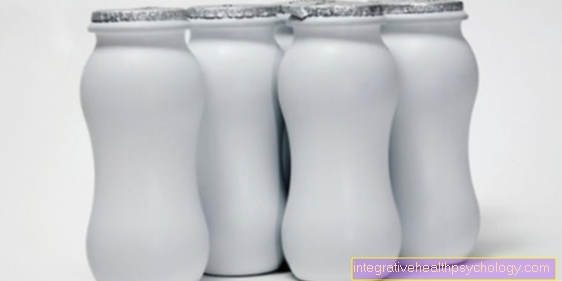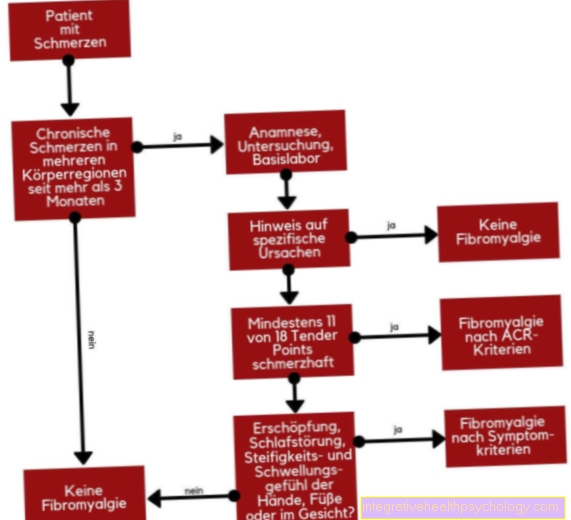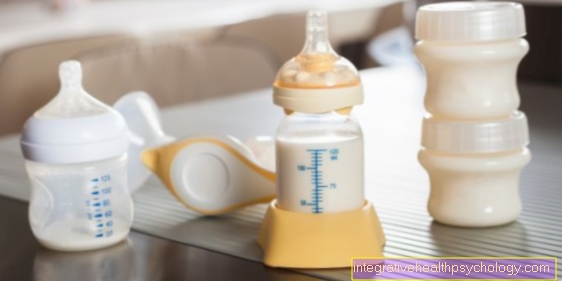Kernicterus
What is kernic terus?
Kernicterus is an increased accumulation of bilirubin in the brain that can occur in newborns. Various causes and development mechanisms play a role here. Jaundice is jaundice that can occur in newborns as well as adults due to increased bilirubin levels, especially in the eyes and skin.
Bilirubin is a breakdown product of hemoglobin, which can increasingly circulate freely in the blood due to disorders of the blood cells or metabolic processes in the liver. If there is a rapid increase in bilirubin in newborns, this can cross the blood-brain barrier and lead to severe damage in the brain. In the worst case, this brain disease, the so-called "encephalopathy", can even lead to death.
Read about this too: Jaundice of the newborn

Causes of Kernic Kerus
Jaundice can have numerous causes and, in addition to disorders of the blood cells, can also be attributed to diseases of the liver or biliary tract. The peculiarity of kernicterus, however, is that jaundice is mainly caused by disorders of the blood cells, since bilirubin is only chemically able to cross the blood-brain barrier in this part of the circulation. In the newborn, various processes can cause the red blood cells to dissolve and destroy, which in turn leads to the release of more bilirubin.
The reasons for this are:
- Prematurity
- Lack of food
- Hypothyroidism
- Birth trauma
- Neonatal infection
- Blood group or rhesus factor incompatibility
- Liver metabolic diseases
- Taking certain medications
On the other hand, there may also be damage to the blood-brain barrier, which means that normally high bilirubin levels can cause kernicterus.
This case can occur with:
- Lack of oxygen
- Hypothermia
- Hypoglycaemia
of the newborn.
I recognize kernicterus by these symptoms
The neurological symptoms in a newborn are not as clear-cut as in an adult, so it is important to watch out for certain signs in the child's behavior.
In the initial stages of kernicterus, the child may appear sleepy and attract attention due to poor drinking and a sedentary lifestyle.
Later the symptoms can change into increased excitability with high-pitched screaming and a very tense muscle tone of the spine. In addition, the newborn's consciousness decreases, so that a coma can occur over time, with increased muscle tone and seizures.
Kernicterus can cause severe symptoms even in the long term. This includes spastic paralysis of many muscles, hearing impairment, paralysis of certain eye muscles, and possibly a reduced intelligence.
Read about this too: Kernicterus in the baby
Diagnosis of kernicterus
The diagnosis of kernic terus is made on the basis of clinical abnormalities and laboratory tests. A laboratory test should be carried out if the newborn child has yellow skin before the 3rd or after the 10th day of life. If the bilirubin level in the blood is significantly increased, further diagnostic tests should be attempted to determine the cause of the increase.
Further blood values can provide clues as to whether a cell breakdown of the red blood cells, an organ disorder of the liver or a serious metabolic disease is behind the jaundice. Certain symptoms and neurological abnormalities in the child provide evidence of kernicterus and thus involvement of the brain.
You might also be interested in the topic: Blood group incompatibility between mother and child
Treatment of kernicterus
The most important therapeutic measure is the so-called "phototherapy". The newborn is illuminated with blue light, whereby the bilirubin is converted in the body in such a way that it can be excreted via the intestines and kidneys. Phototherapy is only useful in certain cases of increased bilirubin levels.
It can also be associated with side effects such as diarrhea, dehydration and, in the worst case, long-term leukemia.
Above a certain bilirubin level, phototherapy is insufficient, which is why a blood exchange transfusion may have to be carried out. In kernicterus, the values are often so high that this therapy is carried out immediately in the acute phase. Donor blood that has the same blood group is transfused.
In order to prevent kernicterus, the child should be given regular and adequate nutrition early after the birth. Breast milk and a protein-rich diet are preferable.
You might also be interested in the topic: Preventive examination of the newborn and phototherapy
How long does kernicterus last?
It is difficult to give a blanket term for the duration of kernicterus. Several factors play a role here. For a short period of time, it is crucial that the kernicterus trigger is resolved, that bilirubin levels are low, and that the jaundice responds quickly to therapy.
If the cause for the increase in bilirubin is not found, the kernicterus can persist and progress despite the therapy started. If possible, the values should be reduced within a few hours to days in order to prevent serious consequential damage. In the long term, however, irreversible damage can persist due to kernic terus.
also read: Jaundice prolongatus - How dangerous is it?
Course of disease
The course of the disease can be very variable. In principle, kernicterus can be extremely acute or chronic. The decisive factor is how brilliant the causal event is, how high the bilirubin levels rise and how well the therapy gets the event under control.
In most cases, it starts with:
- visible yellowing of the skin and eyes
This can lead to the following:
- lethargy
- Poor drinking
- flabby muscles
- sleepiness
Only with a progressive brain disease does the following occur:
- Spasticity
- Convulsions
- shrill screams
- Limitations of consciousness up to a coma
This acute illness is life-threatening.
However, if it is survived, subsequent damage to the brain can be impressive in the years to come. These are mainly neurological deficits such as:
- Muscle paralysis
- Hearing loss
- Developmental delays
- Intellectual disabilities
The full extent of the damage can only be determined while growing up in the following years.
How contagious is kernic terus?
Kernicterus is not an infectious process and is therefore not contagious. However, certain circumstances of the mother can provoke kernicterus in several children in a row. This could be a rhesus incompatibility, which causes maternal antibodies to destroy the child's blood. However, this is not actually a contagion either.





























